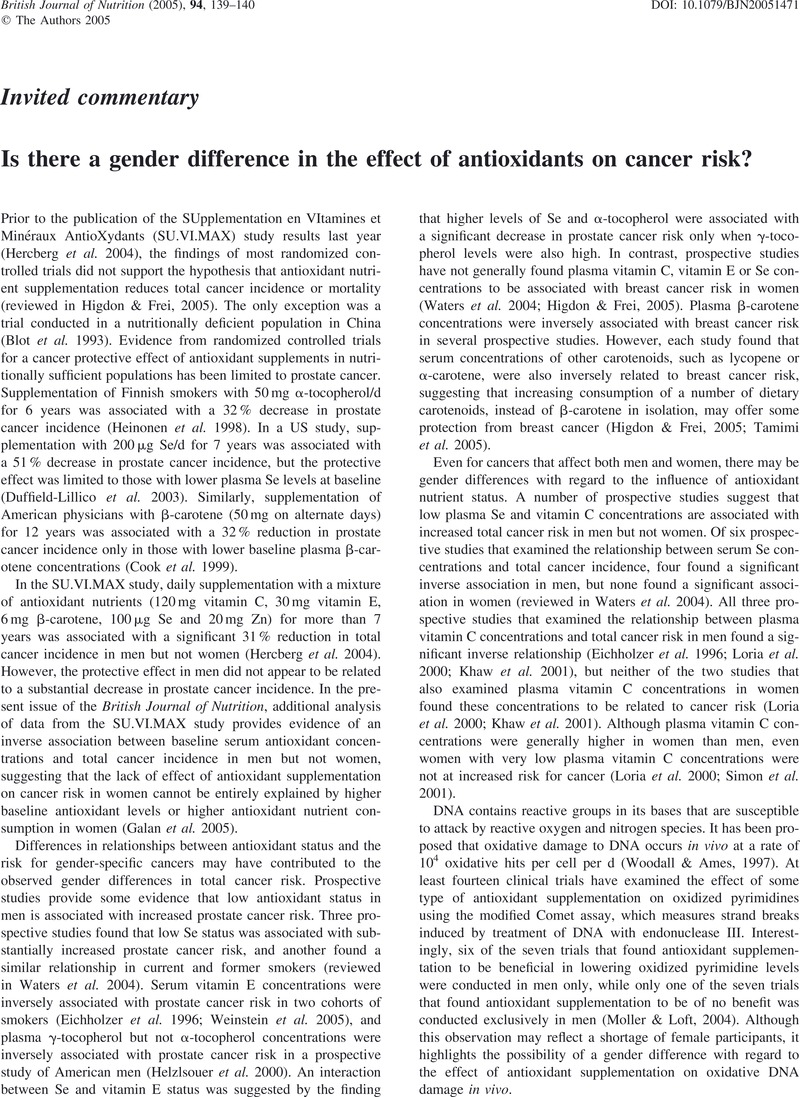Crossref Citations
This article has been cited by the following publications. This list is generated based on data provided by
Crossref.
Koren, Erez
Zverev, Igor
Ginsburg, Isaac
and
Kohen, Ron
2008.
Supplementation with antioxidants fails to increase the total antioxidant capacity of several cell lines in culture.
Biomedicine & Pharmacotherapy,
Vol. 62,
Issue. 3,
p.
179.
Cook, Michael B.
Dawsey, Sanford M.
Freedman, Neal D.
Inskip, Peter D.
Wichner, Sara M.
Quraishi, Sabah M.
Devesa, Susan S.
and
McGlynn, Katherine A.
2009.
Sex Disparities in Cancer Incidence by Period and Age.
Cancer Epidemiology, Biomarkers & Prevention,
Vol. 18,
Issue. 4,
p.
1174.
Cook, Michael B.
McGlynn, Katherine A.
Devesa, Susan S.
Freedman, Neal D.
and
Anderson, William F.
2011.
Sex Disparities in Cancer Mortality and Survival.
Cancer Epidemiology, Biomarkers & Prevention,
Vol. 20,
Issue. 8,
p.
1629.
Qiu, Li
Sautter, Jessica
and
Gu, Danan
2012.
Associations between frequency of tea consumption and health and mortality: evidence from old Chinese.
British Journal of Nutrition,
Vol. 108,
Issue. 9,
p.
1686.
Najari, Bobby B.
Rink, Michael
Li, Philip S.
Karakiewicz, Pierre I.
Scherr, Douglas S.
Shabsigh, Ridwan
Meryn, Siegfried
Schlegel, Peter N.
and
Shariat, Shahrokh F.
2013.
Sex Disparities in Cancer Mortality: The Risks of Being a Man in the United States.
Journal of Urology,
Vol. 189,
Issue. 4,
p.
1470.
Audenet, François
Méjean, Arnaud
Chartier-Kastler, Emmanuel
and
Rouprêt, Morgan
2013.
Adrenal tumours are more predominant in females regardless of their histological subtype: a review.
World Journal of Urology,
Vol. 31,
Issue. 5,
p.
1037.
Radkiewicz, Cecilia
Johansson, Anna L.V.
Dickman, Paul W.
Lambe, Mats
and
Edgren, Gustaf
2017.
Sex differences in cancer risk and survival: A Swedish cohort study.
European Journal of Cancer,
Vol. 84,
Issue. ,
p.
130.
Drahos, Jennifer
Ricker, Winnie
Pfeiffer, Ruth M.
and
Cook, Michael B.
2017.
Metabolic syndrome and risk of esophageal adenocarcinoma in elderly patients in the United States: An analysis of SEER‐Medicare data.
Cancer,
Vol. 123,
Issue. 4,
p.
657.
Chen, Ziren
Mai, Wei
Li, Zhengxiong
Zhang, Haoyang
Zheng, Yu
Hong, Shunrong
Yang, Wencong
Xiao, Weiliang
Chen, Zhilin
and
Wang, Shuncong
2019.
The epidemiological trend of acute promyelocytic leukemia over past four decades: a population-based analysis.
Leukemia & Lymphoma,
Vol. 60,
Issue. 14,
p.
3470.
Burkill, Sarah
Tan, Chuen Seng
Lau, Jerrald
Koh, Gerald Choon-Huat
and
Tan, Ker Kan
2021.
Colorectal cancer incidence in a multi-ethnic population: Age-period-cohort analysis of trends in Singapore.
Cancer Epidemiology,
Vol. 75,
Issue. ,
p.
102046.
Huang, Lanhui
Chen, Huihe
and
Liang, Min
2024.
The Association Between Habitual Tea Consumption and Frailty Transition in Community-Dwelling Older Adults: A Prospective Cohort Study.
Journal of the American Medical Directors Association,
Vol. 25,
Issue. 2,
p.
259.
